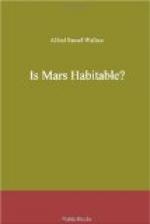[Footnote 15: The coefficient of contraction of basalt is 0.000006 for 1 deg. F., which would lead to the results given here.]
[Footnote 16: Mr. W.H. Pickering observed clouds on Mars 15 miles high; these are the ‘projections’ seen on the terminator when the planet is partially illuminated. They were at first thought to be mountains; but during the opposition of 1894, more than 400 of them were seen at Flagstaff during nine months’ observation. Usually they are of rare occurrence. They are seen to change in form and position from day to day, and Mr. Lowell is strongly of opinion that they are dust-storms, not what we term clouds. They were mostly about 13 miles high, indicating considerable aerial disturbance on the planet, and therefore capable of producing proportional surface denudation.]
Suggested Explanation of the ’Oases.’
The numerous round dots seen upon the ‘canals,’ and especially at points from which several canals radiate and where they intersect—termed ‘oases’ by Mr. Lowell and ‘craterlets’ by Mr. Pickering may be explained in two ways. Those from which several canals radiate may be true craters from which the gases imprisoned in the heated surface layers have gradually escaped. They would be situated at points of weakness in the crust, and become centres from which cracks would start during contraction. Those dots which occur at the crossing of two straight canals or cracks may have originated from the fact that at such intersections there would be four sharply-projecting angles, which, being exposed to the influence of alternate heat and cold (during day and night) on the two opposite surfaces, would inevitably in time become fractured and crumbled away, resulting in the formation of a roughly circular chasm which would become partly filled up by the debris. Those formed by cracks radiating from craterlets would also be subject to the same process of rounding off to an even greater extent; and thus would be produced the ‘oases’ of various sizes up to 50 miles or more in diameter recorded by Mr. Lowell and other observers.




